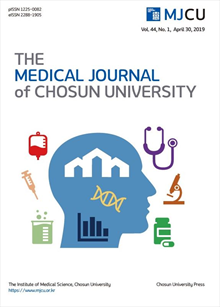간행물
The Medical Journal of Chosun University 조선대학교 의대논문집

- 발행기관 조선대학교 의학연구원
- 자료유형 학술지
- 간기 반년간
- ISSN 1225-0082 (Print)2288-1905 (Online)
- 수록기간 2013 ~ 2019
- 주제분류 의약학 > 의학일반 의약학 분류의 다른 간행물
- 십진분류KDC 510DDC 610
권호리스트/논문검색
Vol. 41 No. 1 (2016년 3월) 8건
Case report
1.
2016.03
서비스 종료(열람 제한)
Lupus anticoagulant-hypoprothrombinemia syndrome (LAHS) is a rare disease associated with lupus anticoagulant and factor II deficiency. LAHS is usually associated with autoimmune disease or with transient viral infection. A 27-month-old boy had a gross hematuria. Prothrombin time (PT) and activated partial thromboplastin time (aPTT) were markedly prolonged. The aPTT was not corrected after mixing with normal plasma. The level of factor II was decreased. Diluted Russell's viper venom test demonstrated the lupus anticoagulant. He was diagnosed with LAHS. His clinical symptom was improving without medical treatment. Serial laboratory studies showed that PT, aPTT, and factor II level were normalized.
2.
2016.03
서비스 종료(열람 제한)
3.
2016.03
서비스 종료(열람 제한)
Invasive fungal infection can be a lethal complication in systemic lupus erythematosus (SLE). Crytococcus neoformans, as one of the most common pathogenic species worldwide, can cause infection disease in human. The central nervous system (CNS) is a common site for cryptococcal infection which usually presents cryptococcal meningitis. The cryptococcal meningitis is a recognized complication of SLE, with high mortality rates, particularly in those treated with immunosuppressive agents. However, it is difficult to differentiate infectious meningitis and neuropsychiatric lupus because of the clinical manifestations are unspecific and frequently are confused with lupus activity. So a early diagnosis and treatment is very important for its significant mortality and morbidity. We report the case of fatal meningoencephalitis by Cryptococcus neoforman in a 44 years old patient with SLE
Original article
4.
2016.03
서비스 종료(열람 제한)
The aim of this study is to investigate the effects of tea catechin on fasting blood glucose in experimental diabetes model. Type 2 diabetes mellitus in rats was induced by high fat diet/low-dose streptozotocin. The experimental group was divided into 3 different groups, non-diabetes control (NC) group, diabetes mellitus (DM) group, and diabetes mellitus+P60 (DM+P60) group. Polyphenon 60(P60) administered with dissolved in 0.2% dringking water. At 16 weeks after P60 treatment, fasting blood glucose, plasma insulin and serum triglyceride levels were measured. The glucose metabolism-related genes were studied in rat liver by RNA-seq analysis. Fasting blood glucose levels increase by four times in the DM group compared to the NC group. In the DM+P60 group, it was decreased by 24% compared to the DM group. The HOMA-IR index was increased in the DM group and it decreased in the DM+P60 group compared to the DM group. The serum triglyceride level increased by 148% in the NC group, and decreased by 22% in the DM+P60 group compared to the DM group. Glucokinase mRNA expression was decreased in the liver of DM group compared to NC group, whereas the phosphofructokinase 1, glucose-6-phosphotase and phosphoenolpyruvate carboxykinase expression did not show significant differences in DM group liver. In DM+P60 group, liver glucokinase expression was increased significantly (P: 5.00E-05) compared with DM group. This study shows that P60 beneficially modifies glucose metabolism and markedly enhances glucose tolerance in experimental diabetic rats. Dietary supplementation with P60 could potentially contribute to nutritional strategies for treatment of type 2 diabetes mellitus.
Case report
5.
2016.03
서비스 종료(열람 제한)
Neurofibromatosis type 1 and ataxia telangiectasia are included in neurocutaneous syndrome. Ataxia telangiectasia is well known as the radiation hypersensitivity disease. The radiation sensitivity in neurofibromatosis type 1 is not well known. We report two cases of breast cancer with neurofibromatosis type 1. One patient received postoperative radiation therapy on left chest wall. The other patient received postoperative radiation therapy on right chest wall and supraclavicular area. We observed clinical radiosensitivity in these patients. Both patients did not show any acute adverse clinical response in chest wall and lung. Further evaluation of radiosensitivity in patients with neurofibromatosis type 1 is needed.
6.
2016.03
서비스 종료(열람 제한)
Salmonellae are gram-negative bacilli of the family Enterobacteriaceae. Gastroenteritis was the most frequent clinical sign and osteoarticular infection like septic arthritis were extremely scarce in a patient with Salmonella infection. An immunocompromised state are known risk factors for development of septic arthritis due to Salmonella. The treatment of rheumatoid arthritis (RA) has recently seen a paradigm shift with the introduction of biological therapy. Tumor necrosis factor-alpha antagonist (anti TNF-α) have especially been able to play major roles in the treatment of RA. But there is concern that this will result in an increased incidence of infection. There have been few reports of Salmonella infection following anti TNF-α in a RA patient. Here, we report a rare case of septic arthritis of the left knee by Group B non-typhoidal Salmonella in a RA patient who was receiving etanercept therapy. The patients was treated with arthroscopy guided irrigation and debridement, and administration of intravenous antibiotics (ciprofloxacin) for 4 weeks. Since then, he achieved a full recovery from the infection.
7.
2016.03
서비스 종료(열람 제한)
23-year old male tae-kwon-do athlete visited with both Achilles tendon rupture after landing both lower limbs at the same time performing kick motion on the same day. Rt. achilles tendon was treated with open tenorrhapy by modified Bunnel method, and Lt. achilles tendon was treated with minimal invasive suture with Achillon. In young tae-kwon-do athlete both Achilles tendon rupture is very rare without any causing factors. From this case, we need to consider the possibilities of both Achilles tendon rupture in young patients during exercise and precaution is needed especially in landing movement.
8.
2016.03
서비스 종료(열람 제한)

